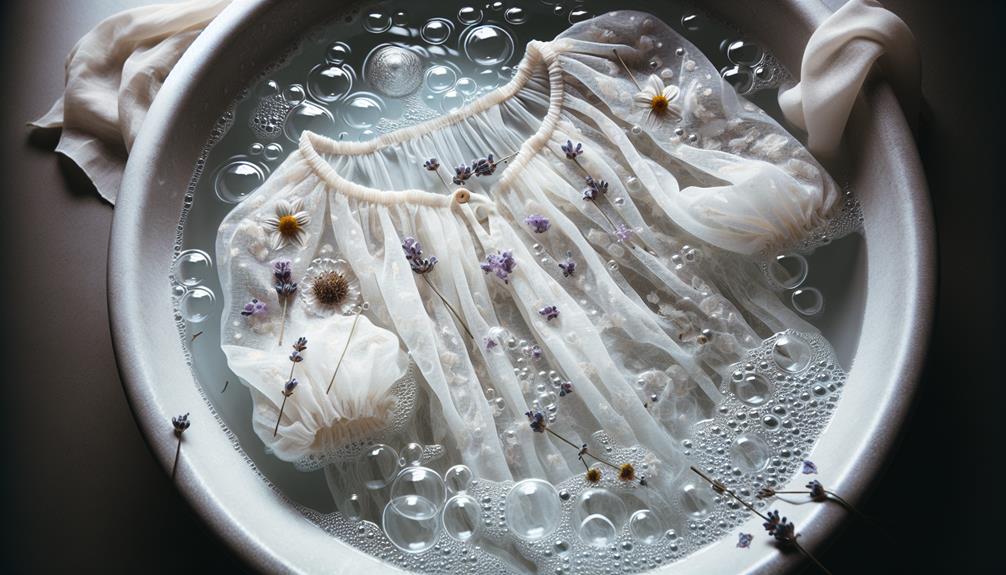Yes, I can wash chiffon, but I've got to be extra careful with it. It's a delicate fabric, so I always hand wash it gently in lukewarm water with a mild detergent. I make sure to sort it by color to avoid any color bleeding. When it comes to drying, I never wring it out. Instead, I gently press the water out and lay it flat to air dry in a well-ventilated area. I use a low heat setting for ironing and always place a press cloth between the iron and the chiffon. There's even more on caring properly for chiffon to keep it looking its best.
Table of Contents
Key Takeaways
- Chiffon can be hand washed gently using lukewarm water and a mild detergent.
- Always sort chiffon garments by color to prevent dye bleeding during washing.
- Avoid wringing out chiffon; instead, gently press out water and lay flat to dry.
- For best results, dry cleaning is recommended to preserve the fabric's texture and structure.
- Use a low heat setting and a press cloth when ironing chiffon to avoid damage.
Understanding Chiffon Fabric
What exactly is chiffon, and why is it so popular in fashion?
Chiffon is a lightweight, sheer fabric known for its sheer, airy appearance and elegant drape. Typically made from silk, cotton, nylon, or polyester, this fabric is a favorite among designers for its soft, graceful flow and slightly textured feel. Its slight stretch and transparent quality make it ideal for layering in skirts, dresses, scarves, and blouses.
It's the go-to material for evening wear and wedding dresses because it adds a touch of sophistication and luxury without being overly heavy or stifling. The fabric's lightness ensures it moves beautifully, perfect for capturing that ethereal, floaty look that's highly sought after in many fashion circles.
Handling chiffon can be tricky due to its delicate nature. It requires a gentle touch, whether you're sewing or wearing it, to prevent snags and tears. When I'm working with chiffon, I always make sure my workspace is free of any sharp objects, and I use very sharp scissors and fine needles to maintain the integrity of the fabric.
Understanding these characteristics of chiffon, you can appreciate why it's chosen for so many high-end and special occasion garments.
Pre-Wash Fabric Inspection
Before I toss my chiffon into the wash, I always make sure to check for any signs of damage. It's crucial to spot any tears or pulls because washing can make them worse.
I also test for color fastness to avoid any dye bleeding disasters.
Identify Fabric Damage
I always check my chiffon for any signs of damage like tears or discoloration before deciding to wash it. It's crucial because even a small tear can turn into a big problem after washing.
I look closely at the seams and edges, where wear is most likely to show up. If I find minor pulls, I consider if they're fixable or if washing could worsen them. Discoloration can be a sign of previous damage or stains setting in deeper.
I also feel the fabric between my fingers, checking for thinning areas that mightn't be visually apparent but could lead to holes. This careful inspection saves me from ruining delicate chiffon pieces by addressing problems before they escalate in the wash.
Check Color Fastness
To ensure the colors in your chiffon don't bleed, it's smart to test for color fastness before tossing it in the wash.
I usually start by dampening a small, hidden area of the fabric with water, then pressing a white cloth against it. If any dye transfers onto the white cloth, that's a red flag—your chiffon isn't colorfast.
This simple test saves me from potential disasters, like a whole load of laundry getting ruined by colors that run. If the fabric fails this test, I opt for dry cleaning instead to preserve the garment's vibrant hues.
Sorting Chiffon by Color
Before we toss our chiffon into the wash, it's crucial to sort it by color. Grouping similar colors together can help prevent any unwanted color bleeding.
I'll show you some effective techniques to keep your fabrics looking their best.
Color Grouping Techniques
Sorting chiffon by color before washing can prevent dye transfer and keep colors vibrant. I start by separating my chiffon items into three basic groups: whites, darks, and colors. It's crucial to be thorough here. Even a light pastel can bleed into whites, so I keep those with similar pale shades together.
Then, I tackle the darks, ensuring that very saturated items like deep blues or blacks get their own cycle if they're new or I haven't washed them often. This extra step helps avoid surprises.
For the rest, it's about matching intensity. Bright colors go together; this method minimizes the risk of a vibrant pink dulling a softer orange. It's all about protecting the fabric and the brilliance of its colors.
Preventing Color Bleeding
I've outlined how to group chiffon by color, and now let's focus on how this practice helps prevent color bleeding during washing.
Sorting your chiffon garments by color, especially separating darks and lights, is crucial. This isn't just about maintaining the fabric's integrity; it's about ensuring colors stay vibrant without transferring onto lighter pieces. When darks bleed, they can dull the bright, delicate hues of your lighter chiffons.
Choosing the Right Detergent
Selecting the right detergent is crucial for effectively cleaning chiffon without damaging the fabric. I've found that opting for a mild, liquid detergent is key. You'll want to steer clear of anything too harsh or heavily formulated with chemicals, as these can break down the delicate fibers of chiffon. It's not just about keeping the fabric intact; it's also about ensuring that the finish and feel of the chiffon remain as luxurious as when you first bought it.
I always check for detergents labeled “gentle” or “for delicates.” These products are specifically designed to cleanse effectively while being easy on fabrics that need more care. Don't be tempted by stronger detergents just because they promise powerful stain removal. It's better to treat stains on chiffon with specific spot treatment methods rather than relying on the brute force of a detergent.
Moreover, I avoid detergents with added fragrances or dyes. They can leave residues that might irritate the skin or alter the chiffon's appearance. A hypoallergenic detergent is a safe bet, offering a clean wash without any unnecessary additives that could compromise the fabric's integrity. Remember, the goal is to clean, not complicate.
Hand Washing Techniques
Once you've chosen the right detergent, it's time to master the gentle art of hand washing your chiffon. This delicate fabric demands a subtle touch, so let's dive in.
First, fill your basin with lukewarm water — too hot and you risk damaging the fibers. Add a small amount of your selected detergent and swirl it around to mix well. Now, lay your chiffon garment in the water. Don't just drop it in; ease it down to ensure it's thoroughly wet without twisting or wringing, which can distort the fabric.
Next, gently swish the chiffon through the water. Imagine you're miming the garment swimming; it's all about gentle motions. After a few minutes, carefully lift the fabric and replace the soapy water with fresh, clean water for rinsing. Repeat the gentle swishing to remove any soap residue. You might need to change the rinse water a few times until it's clear.
Once the soap is out, don't wring the chiffon. Instead, lay it flat on a clean, dry towel. Roll the towel and garment together to press out excess water, then unroll and lay flat to air dry. Mastery in these steps ensures your chiffon remains pristine and perfect.
Machine Washing Guidelines
While hand washing is preferred for chiffon, using a washing machine isn't out of the question if you follow the right guidelines. First off, always check the care label on your chiffon garment. If it says “machine washable,” you're good to go, but proceed with caution.
I start by placing my chiffon in a mesh laundry bag to protect it from snagging or tangling during the wash cycle. Choose a gentle cycle on your washing machine; this setting uses a slower spin and less agitation, reducing the risk of damage. It's crucial to use cold water because hot water can cause shrinking and fading.
For detergent, I opt for a mild, liquid detergent. Powder detergents can be too harsh for delicate fabrics like chiffon. Also, ensure you use a small amount; too much soap can leave residue and might require an extra rinse.
Lastly, never overload your washer. Chiffon needs space to move freely in the water to prevent excessive pulling or stretching of the fibers. I usually wash chiffon items with other delicate or similarly lightweight fabrics to maintain balance in the machine. Following these steps helps keep your chiffon looking its best.
Drying Methods for Chiffon
After washing, drying chiffon properly is crucial to maintain its delicate texture and shape. Here's how I handle this tricky task.
First, I never wring out chiffon; it's a surefire way to damage the fabric. Instead, I gently press the water out. Lay the garment flat on a clean, dry towel, roll it up gently to absorb the excess water, then unroll.
Next, I avoid using a dryer. The heat and tumbling motion can cause shrinkage or misshaping. Instead, I lay the chiffon flat to air dry. I use a drying rack, but ensure it's either covered with a soft towel or it's a mesh type that won't snag the fabric. Placing it flat preserves the shape and avoids new creases forming.
I also keep it out of direct sunlight. While sunlight helps some fabrics dry faster, it can fade chiffon quickly, especially if it's a vibrant or dark color. I prefer a well-ventilated area that doesn't get direct light. This way, I ensure my chiffon items dry evenly without any color loss or material damage.
Following these steps, I've managed to keep my chiffon looking great, avoiding premature wear and tear.
Ironing Tips for Chiffon
Ironing chiffon requires a gentle touch to avoid damaging its delicate fibers. When I tackle the task, I've found that the key is all in the preparation and the tools I use. Let's break down the essentials for ironing this tricky fabric without any mishaps.
Firstly, always check the garment's care label. Chiffon can be made from silk or synthetic fibers, and each may require different heat settings. I've learned the hard way that assuming all chiffon irons the same can lead to disaster!
Here's what works for me:
- Low Heat Setting: I always set my iron to the lowest heat setting. Chiffon is susceptible to heat, and high temperatures can cause it to burn or melt.
- Press Cloth: Using a press cloth is non-negotiable. It acts as a barrier between the iron and the chiffon, minimizing heat damage and preventing those shiny marks that can appear if the iron touches the fabric directly.
- No Steam: I avoid using steam. Chiffon handles moisture poorly, and steam can leave watermarks that are tough to get out.
Adhering to these tips ensures my chiffon stays in pristine condition, and I avoid any ironing blunders that could ruin my favorite delicate pieces.
Storing Chiffon Properly
After tackling how to wash and iron chiffon, let's talk about storing it right to avoid any damage.
It's crucial to pick the proper storage methods and be mindful of the best conditions, like the ideal temperature and humidity.
This way, you'll keep your chiffon looking great for years.
Choosing Right Storage Methods
Proper storage is crucial for maintaining the delicate fabric of chiffon. I've found that how you store your chiffon garments can significantly impact their lifespan and appearance. Here's what I always keep in mind:
- Location: Choose a cool, dry place away from direct sunlight. Moisture and heat are enemies of chiffon.
- Hanging vs. Folding: Whenever possible, hang chiffon dresses on padded hangers to avoid creases. For storage, folding should be done with tissue paper to prevent wrinkles.
- Breathability: Opt for cloth garment bags or a well-ventilated area. Plastic can trap moisture, which might lead to damage.
Sticking to these pointers ensures my chiffon stays in pristine condition, ready for any occasion.
Avoiding Damage During Storage
Building on the right storage methods, let's explore how to avoid damaging chiffon while it's stored.
First off, always use padded hangers if you're hanging chiffon garments. This prevents the delicate fabric from stretching or getting misshapen. For folding, wrap the chiffon in acid-free tissue paper before placing it in a box. This extra layer shields it from dust and other contaminants.
Avoid overcrowding your storage space. Chiffon needs to breathe, so don't pack it too tightly with other items. Also, steer clear of storing chiffon near rough materials; these can snag and pull the fine threads. Finally, keep it away from direct sunlight, as UV rays can degrade chiffon over time.
Ideal Temperature and Humidity
Maintaining the right temperature and humidity is crucial when storing chiffon to prevent damage. I've found that chiffon, a delicate fabric, reacts poorly to extreme conditions. Here's what I stick to for optimal care:
- Temperature: Keep it cool, ideally between 18-22°C. Chiffon doesn't take kindly to heat.
- Humidity: Aim for a moderate humidity level, around 50-55%. Too dry or too damp can wreak havoc.
- Air Circulation: Good airflow prevents moisture buildup, which is a top enemy of chiffon.
Ensure these conditions are met in your storage area to keep your chiffon pieces in pristine condition. It's all about creating a stable environment to avoid fabric stress and deterioration.
Common Mistakes to Avoid
When washing chiffon, it's crucial to avoid common mistakes that could damage the fabric. First off, don't go tossing your chiffon garments into the washing machine with everything else. Even on a gentle cycle, the agitation is too harsh and can cause tears. It's tempting, I know, but handwashing is your best bet here.
Another big no-no is using hot water. Chiffon's delicate nature means that hot water can shrink or misshape it, so always stick to cold water. And while we're on the subject, avoid wringing out chiffon after washing. It seems like a quick way to get rid of excess water, but you're likely to stretch or distort the fabric. Instead, gently squeeze the water out or let it drip dry.
Also, steer clear of harsh detergents. A mild soap is sufficient and much safer for maintaining the integrity of chiffon. Harsh chemicals can break down the fibers over time, dulling the vibrant look of your garment.
Lastly, don't rush the drying process by putting chiffon in the dryer. The intense heat and tumbling action are a recipe for disaster. Always air dry, and you'll keep your chiffon looking graceful and elegant.
Removing Stains From Chiffon
Removing stains from chiffon requires careful handling to avoid damaging the delicate fabric. When I spot a stain on my chiffon clothing, I know it's essential to act quickly but gently. Here's how I tackle this tricky task:
First, I lightly dab the stain with a mixture of mild soap and water, using a soft cloth. Rubbing too hard can break the fibers, so I make sure to be as gentle as possible. If the stain persists, I move on to a targeted approach using a stain remover suitable for delicate fabrics. It's crucial to test the stain remover on an inconspicuous area of the garment first to ensure it doesn't alter the color or texture.
Here are a few key tips to remember when dealing with stains on chiffon:
- Blot, Don't Rub: Pat the stained area gently; rubbing can spread the stain and weaken the fabric.
- Cool Water is Best: Always use cool water for treating stains as hot water can set them permanently.
- Natural Drying: Avoid wringing out the fabric. Instead, lay the garment flat on a towel to air-dry.
Professional Cleaning Options
Despite my best efforts at home, sometimes I find it's better to leave chiffon care to the professionals. When it comes to preserving the integrity and appearance of my chiffon garments, I've learned that professional cleaning is a solid choice. They've got the right tools and expertise to handle this delicate fabric, which can easily get damaged if I'm not careful.
Dry cleaning is the most common method recommended for chiffon, especially if the fabric is a blend or has elaborate embellishments like sequins or beads. The solvents used in dry cleaning don't interact with the fabric in the same way water does, which helps maintain the structure and texture of the material. It's also a safer bet for removing stains without risking fabric damage.
I always make sure to discuss my chiffon items with the cleaners beforehand, ensuring they're aware of the material and any specific concerns I might have. This proactive communication helps prevent any mishaps. Additionally, I look for cleaners who specialize in handling delicate fabrics. Their expertise often means they offer tailored services such as hand washing or specific spot treatments that maintain the quality of chiffon without the harshness of regular washing.
Frequently Asked Questions
Can Chiffon Be Dyed at Home, and How?
Yes, I've dyed chiffon at home using fabric dye and a gentle hand-wash method. It's crucial to follow the dye instructions precisely and test on a small area first to avoid ruining the fabric.
Are There Eco-Friendly Alternatives to Dry Cleaning Chiffon?
Yes, there are eco-friendly alternatives to dry cleaning chiffon. I've used mild, biodegradable detergents and hand-washed my chiffon items carefully. It's effective and avoids harsh chemicals typically used in traditional dry cleaning.
How Does Sunlight Exposure Affect Chiffon Fabric?
Sunlight exposure can fade chiffon's colors and weaken its fibers over time. I recommend drying it in the shade to preserve its appearance and extend its lifespan. Always handle chiffon with care.
Can Chiffon Garments Be Altered Easily?
Altering chiffon garments isn't easy; it's delicate and prone to damage. I've learned that careful handling and experienced tailors are key, as nearly 70% of alterations could otherwise end in tears.
What Is the Historical Origin of Chiffon Fabric?
Chiffon originated in France around the 1700s. It's a lightweight, sheer fabric made from silk or synthetic fibers, initially exclusive to the elite due to its delicate and luxurious nature.
- Can Chiffon Be Washed? - April 23, 2024
- Is Chiffon Good for Wedding? - April 23, 2024
- What Is Chiffon Best Used For? - April 23, 2024








